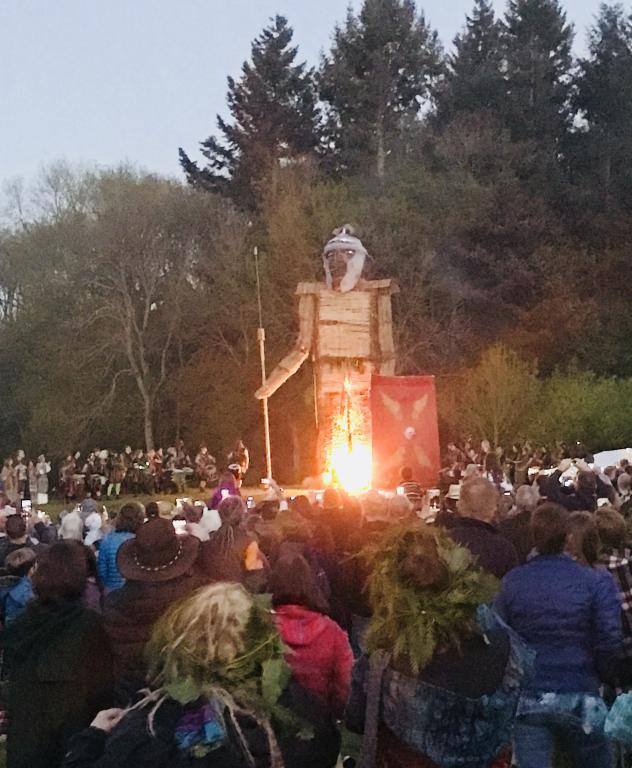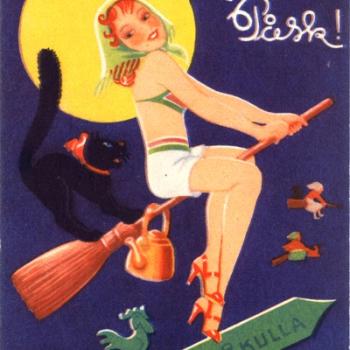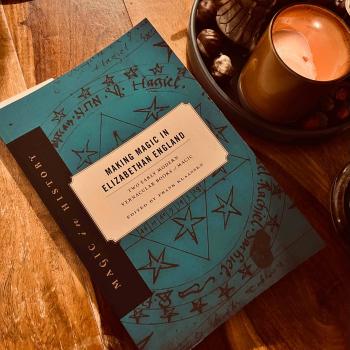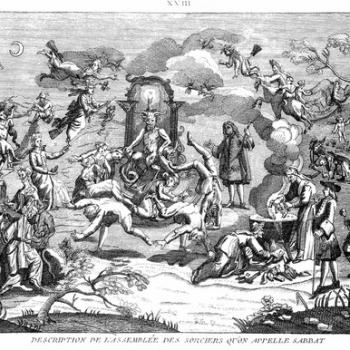Butser Ancient Farm, Hampshire, UK
Saturday 5th May – Beltane.
As the heady temperatures of the UK continued into the Bank Holiday weekend, without the customary threat of rain on the horizon, and the hour crept later in the afternoon, there seemed little else for it but to heed the call of Beltane and an appointment with the Wicker Man.
Butser Ancient Farm is an ‘open-air research laboratory’ into the past, an experimental archeological farm that is exploring the past through engaging in it. Through this, the historians, archeologists, volunteers and staff present an educational insight into the ancient past through a working farm, Stone Age dwellings, reconstructed round houses, a Roman villa and a Saxon hall. In addition, Butser Ancient Farm provides trips for schools and educational organisations, as well as visitors, where they can discover our history through direct learning, with archeological dig pits, and an assortment of activities connecting us with the ancestors. This remarkable and beautiful farm, located in a quiet valley in Hampshire, surrounded by woodland and field, provides a backdrop which transports visitors to a world that is not forgotten but remembered. With a busy events calendar of talks, workshops, activities and festivities, there is sure to be something that will capture the imagination of young and old and rekindle that love of the ways of our ancestors.

So it is nestled in the valley of Hampshire within an ancient farmstead that Beltane is celebrated in vigour, culminating in the burning of a giant Wicker Man which is the highlight of the event.
Making absolutely the best use of this working location, the event was occupied in each of its historic areas with appropriate living history activities, talks, demonstrations, workshops and re-enactments. There was a delicious array of catering stalls, offering homemade cakes, vegan dhal, gourmet burgers, as well as the obligatory and universal favourite hog roast. There was a large beer tent offering a selection of quality cask ales, perry and cider, and all at reasonable prices. For the connoisseur, there was also a stall selling superb mead in a variety of flavours, including elderflower, nettle and chilli, as well as the simply sumptuous traditional mead.
A stage area was kept alive with music from Yeehaa Granma and some really powerful drumming from Pentacle Drummers. In addition, there was morris dancing from Hook Eagle Morris, and a host of demonstrations and activities, as well as stalls showing archeological finds, historic artefacts and even HantsAstro with a range of telescopes to observe the heavens.
Within one of the roundhouses, with the ember glow and soft smoke of the hearth fire, children and adults filled the perimeter while the centre ground was occupied by that most ancient of lore keepers, the bard. Dedicated to story telling, this roundhouse provided some wondrous word weaving and initiated young and old into the mysteries of the bard, entering into the mythic realm where tribal morality, law and lore is kept alive. At the entrance, one could see the glowing embers lighting up the bard as he echoed out the tale of the people around the fire, breathing new life into the most ancient of customs. One of the fliers announced the Woodland Bard School, specialists in tree and plant folklore since 1998, and beckoning us to ‘Immerse yourself in the spiritual traditions of the land’ in a compelling introduction.

At the Roman Villa, the civilisational Roman traditions were brought to life with soldiers greeting visitors with ‘Ave’, while another prepared the food of the Empire. You could don some of the equipment of the Legionnaire or just enjoy the remarkable reconstruction of a Roma Villa, replete with wall paintings and furniture. With such an evocative atmosphere, visitors to Pompeii will recognise and feel the same sensations at this place as it so similarly mirrors those buildings preserved for some two-thousand years under ash and pumice. So reminiscent of the ruins of Pompeii is the villa that it felt both familiar and ancient.

The Saxon Hall played home to a group of early English, with the Lord and Lady and the warrior classes represented best. On display was an array of the artefacts that would occupy daily life for the Saxons, including armour, a game similar to draughts or chess, and various other items that accompanied the early English settlers. They were joined by some medicinal uses for plants common among our forebears, providing a remarkable insight into the customs of the early Saxons. With a demonstration of warrior combat training, children could take up the challenge and train themselves with sword and shield, with a dedicated arena for this activity.

Other events throughout the afternoon included falconry displays and maypole dancing, which were the perfect accompaniment to a bite from the hog roast and a pint of beer, more reminiscent of timeless country pursuits. As the fiddler delivered the tune, the participants were instructed in various dances, culminating around the iconic maypole, so indicative of this merry month and attended by the most beautiful sunshine as though Apollo himself was delivering a blessing upon this Hyperborean gathering.

One of the most fascinating demonstrations came from the Stone Age display by AncientCraft, where a camp had been set up and various techniques discussed for flint knapping, polishing axe heads, food and cooking, and much more. The most captivating moment was the demonstration of fire making, that primal technology which sparked the evolution of human kind. As such a promethean knowledge, a crowd lay hypnotized by the methods of creating, capturing and harnessing that single ember which captured the deepest recesses of human instinct somewhere far within us all. The striking of flint, or the friction of the bow-drill, and the intake of breath as smoke began to be emitted and we collectively understood that the most remarkable creative act was occurring before our eyes as it did to those first humans so long ago, and which would propel evolution and technologies at such a rate as we have achieved today. Quite an incredible, yet subtle, display not misunderstood by any as a simple technique but accepted with the gravity it deserved in the setting of Stone Age man. The fascination most apparent was that of the children, who held in awe as the fire was kindled from rock and grasses. Extremely satisfying.

During the day, people could write a wish and deposit it within the Wicker Man prior to his igniting which would deliver the hopes and prayers skyward toward the celestial pole and the heavens. Of course, the Wicker Man was the highlight of the event and, as the sun set over the hill, everybody made their way to the sacrifice.

Reminded that, moments earlier, we had witnessed a Stone Age man create fire, we remained sensitive to the atmosphere of place and purpose as distant, and powerful drumming began. Soon, the Roman legionnaires appeared, accompanied by the Saxon Horde and the Pentacle Drummers, who weaved through the crowd to take up their position at the crown of the hill upon which the Wicker Man stood. The Roman appearance of the Wicker Man is to commemorate the works done over the last year at the Roman Villa section of Butser Ancient Farm, and it was palpable throughout the afternoon and evening that the effort and care over the preservation and exploration of history for the education of all permeates this sacred place.

Eventually, the fire was put to the bales that were gathered about the foot of the Wicker Man and the crowd cheered in delight, as though calling to Helios Himself. Under no illusion that this is a recreation of our ancestral paths, this was a modern homage and felt as truly alive and evocative, taking the traditions of the past, rooted in the ways of our ancestors lives, and bringing them into harmony with the present. The atmosphere of conviviality, respectful celebration and joy continued into the closing moment of the burning of the Wicker Man and the sense that our ancestors had been honoured was unmistakable. As the flames licked the legs of the giant, the crowd waited pensively before anticipation gathered as the fire slowly crept higher. Suddenly, the right leg was consumed rapidly by the fire and the gathering cheered loudly in joy, utterly enchanted by the capricious and yet absorbing nature of the element which has been so significant in the advancement of our species. As the blaze grew, the crowd’s mood moved with it with cheers, followed by an expectant ‘ooooh’, and joyous rapture as the billowing sparks and ash from the fire, glowing bright against the night sky like golden stars, fluttered higher toward the heavens, propelled by the heat of the burning man. All the while, the drummers drummed, the heartbeat of the people, like a conductor for the spirit of the tribe, the ebb and flow of the cries of the crowd as the embodiment of the sacred king was lapped by the tongue of the fire. Finally, like a curtain, the blaze engulfed the man and parts began to droop, or collapse, leaving the skeletal frame burning brightly against the deep blue night sky.

As the group dispersed, some mysterious primal urge sated, each of us climbed over the hill away from the burning man, the occasional glance over the shoulder to confirm that it wasn’t a dream and the skeletal remains of the frame, its body licked clean by the flames of the bonfire, remained defiantly in the distance as a golden outline of a man, like a silhouette of a solar god against the backdrop of the Hampshire valley. The spirit of the Wicker Man lives on, until next time…
















